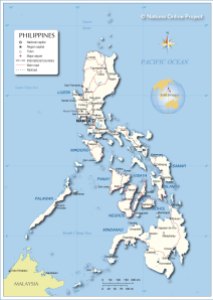For general information about the country profiles click here.
 Population: 96,706,764
Population: 96,706,764
HDI ranking: 114/187
HDI score: 0.654
Although the Local Government Code (LGC) of the Philippines is considered a milestone toward decentralization and governance reformation under the current President Aquino Jr. have taken place, the Philippines is still facing different challenges on the local level.
Local governance at a glance
- The Philippines has four local government units (LGU): 80 provinces, 122 cities, 1,512 municipalities and 42,000 barangays (CenPEG, 2012).
- At all local levels there are elected government officials and local development councils for three-year terms (LGC, 1991).
- At the national level, the Department of the Interior and Local Government is responsible for local government supervision and the Bureau of Local Government Finance of the Department of Finance exercises financial oversight (UCLG, 2006).
- The LGC requires that women be one of three sectoral representatives that reside in every municipal, city, and provincial council (Quota Project, 2014).
Civil society actors
- The Center for People Empowerment in Governance (CenPEG) seeks to empower the marginally poor to play bigger a role in governance, and conducts trainings and education on elections, citizen’s participation and more (CenPEG, 2014).
- The Local Government Development Foundation (LOGODEF) works to strengthen local authorities and promote local governance (LOGODEF, 2013).
- The Galing Pook Foundation (GPF) promotes excellence in good governance, acts as a capacity building institution and awards local government programs (GPF, 2013).
Capacity building institutions
- The Local Government Academy (LGA) is the paramount provider of capacity building services to local government units (LGUs). LGA serves all LGUs nationwide from program designing to training implementation, and other forms of technical assistance. (LGA, 2013).
- The Union of Local Authorities in the Philippines (ULAP) seeks to attain “genuine local autonomy for all LGUs” and ensure “efficient delivery of basic services to local communities” (ULAP, 2014).
- The Working Group on Decentralization and Local Government (PDF WG-DLG), as part of the Philippines Development Forum, aims to “achieve development outcomes through decentralization and local governance” (PDF WG-DLG, 2014).
Fiscal control
- LGUs’ own revenue sources consist of property, local business and community taxes and various fees. This accounts for 32.5% of the LGU budget. Forty percent of domestic taxes (⅔ of LGU’s total revenue) and 40% of income of utilization from the national wealth (natural resources) (0.35% of LGU’s total revenue) are transferred as shared revenues (IMF, 2012).
- LGUs have the right to “determine their own sources of revenues, subject to guidelines and limitations the Congress may provide, consistent with the basic policy of local autonomy” (IMF, 2012).
Key initiatives for participatory governance
- In 1959, the first local autonomy act and the Barrio Carter Act was passed, followed by the Decentralization Act of 1967 and the redrafted Constitution in 1973. However, a true implementation of local autonomy under the authoritarian regime of then President Marcos did not take place (UCLG, 2006).
- The postrevolutionary 1987 Constitution mandated extensive decentralization and increased local autonomy (UCLG, 2006).
- The 1991 Local Government Code is the key instrument of decentralization, providing “devolution, deconcentration and delegation and for decentralization of financial resources to support the devolved basic services” (UCLG, 2006).
- The Local Governance Performance Management System was created in 2001 to help measure effectiveness and efficiency of local government service delivery (UCLG, 2006).
- After the election of President Aquino Jr. in 2010, a series of reforms took place to improve governance and transparency, fight corruption, and empower and strengthen citizens’ direct participation (GIFT, 2013).
Challenges for participatory governance
- Many local governments fail to provide their communities with basic resources and services (Asia Foundation, 2010).
- Corruption and cronyism poses a further problem: “local bosses often control their respective areas, limiting accountability and encouraging abuses of power” (Freedom House, 2014).
- The provisions of the 1991 LGC created vertical and horizontal imbalances. Local governments’ resource bases and tax assignments favor local governments in cities (World Bank, 2011).
Recent posts on this website about this country:
- LogoLink: Learning Initiative on Citizen Participation and Local Governance (2013)
- The specter of leviathan in the central-local relations : a comparative historical analysis of the decentralization reform in Thailand and the Philippines (2013)
- Money, corruption, and political competition in established and emerging democracies (2012)
- Landslide occurrences in the Philippines : contributing factors and implications to local governance (2012)
- Citizen charters : enhancing service delivery through accountability : dealing with governance and corruption risks in project lending (2012)
- DELGO’SEA : partnership for democratic local governance in Southeast-Asia (2012)
- Decentralization program : towards sustainable good local governance (2011)
- Basic services provision across ten years of implementation of the local government code : issues and challenges in decentralized governance (2011)
- The impact of decentralization on large scale irrigation : evidence from the Philippines (2011)
- Community-driven development in post-conflict and conflict-affected areas : experiences from east Asia : background paper for the 2011 World development report (2011)
List of sources:
Asia Foundation, 2010: “Local Governance in the Philippines.”
Center for People Empowerment in Governance (CenPEG), 2012: “20 Years After: Revisiting the Local Government Code.”
Center for People Empowerment in Governance (CenPEG), 2014.
Freedom House, 2014: “Philippines.”
Galing Pook Foundation (GPF), 2013.
Global Initiative for Fiscal Transparency (GIFT), 2013: “Country Report: The Philippines.”
International Monetary Fund (IMF), 2012: “Philippines: Reform of the Fiscal Regimes for Mining and Petroleum.”
Local Government Academy (LGA), 2013.
Local Government Code of the Philippines, 1991.
Local Government Development Foundation (LOGODEF), 2013.
Quota Project, 2014: “Philippines.”
United Cities and Local Governments (UCLG), 2006: “UCLG Country Profiles: Philippines.”
World Bank, 2011: “Ripe for a Big Bang? Assessing the Political Feasibility of Legislative Reforms in the Philippines’ Local Government Code”.
Working Group on Decentralization and Local Government (PDF WG-DLG), 2014.
